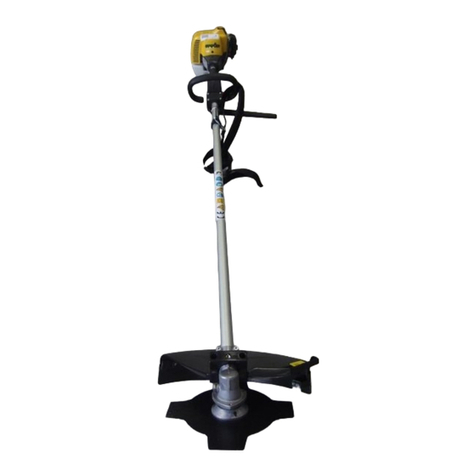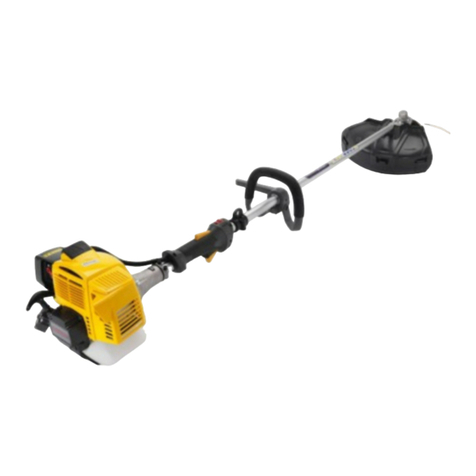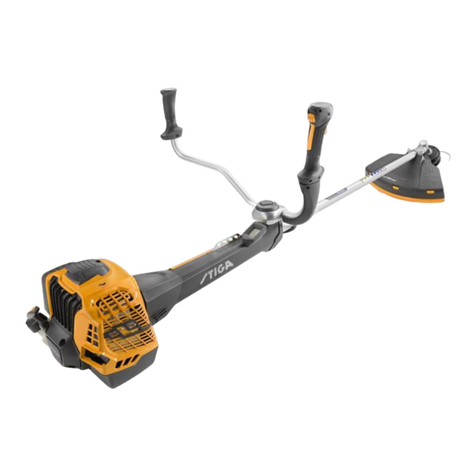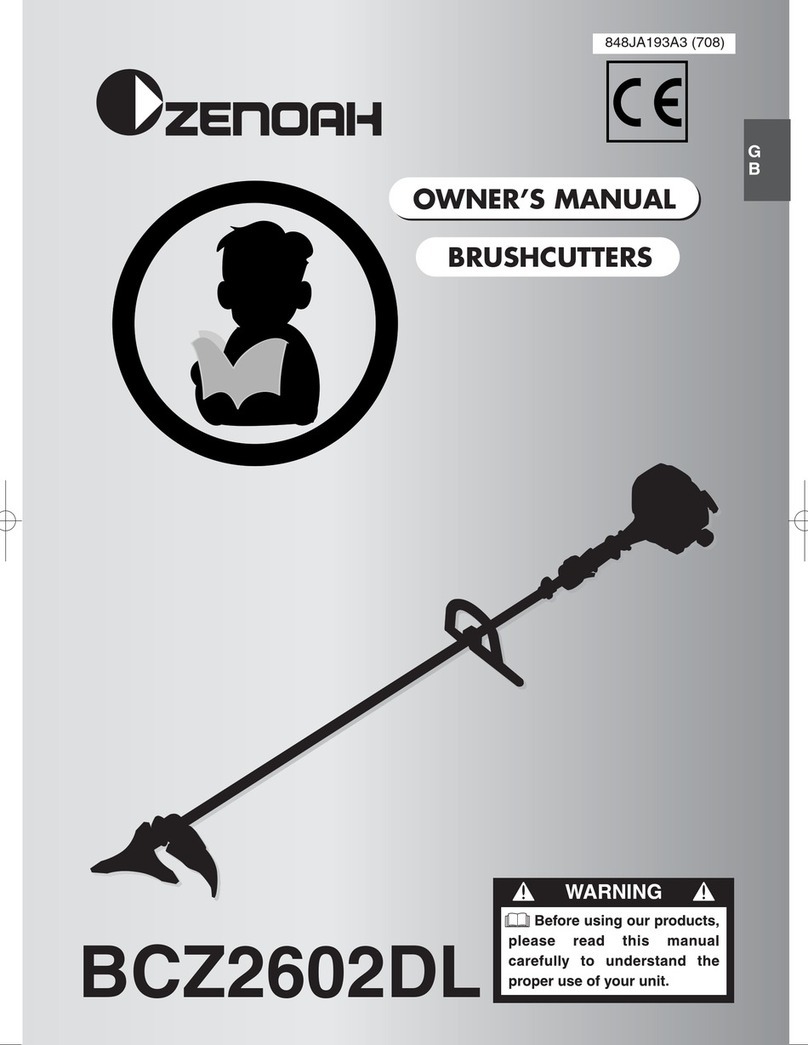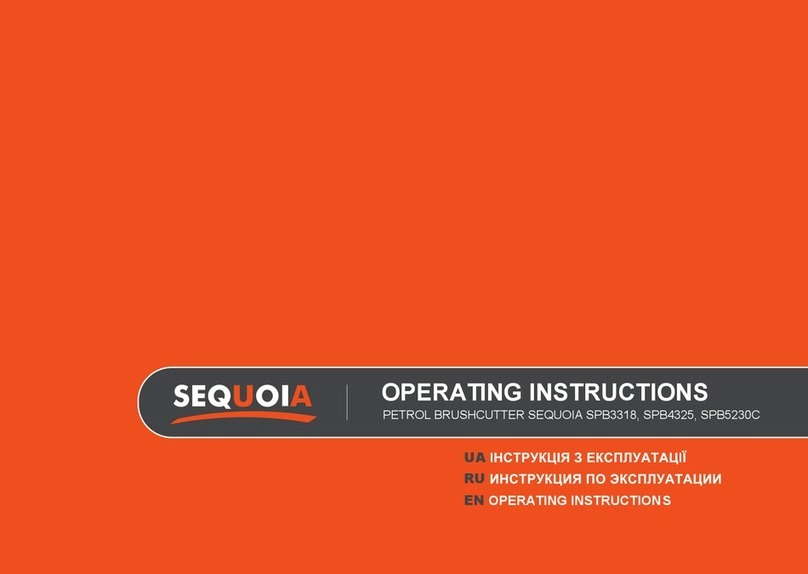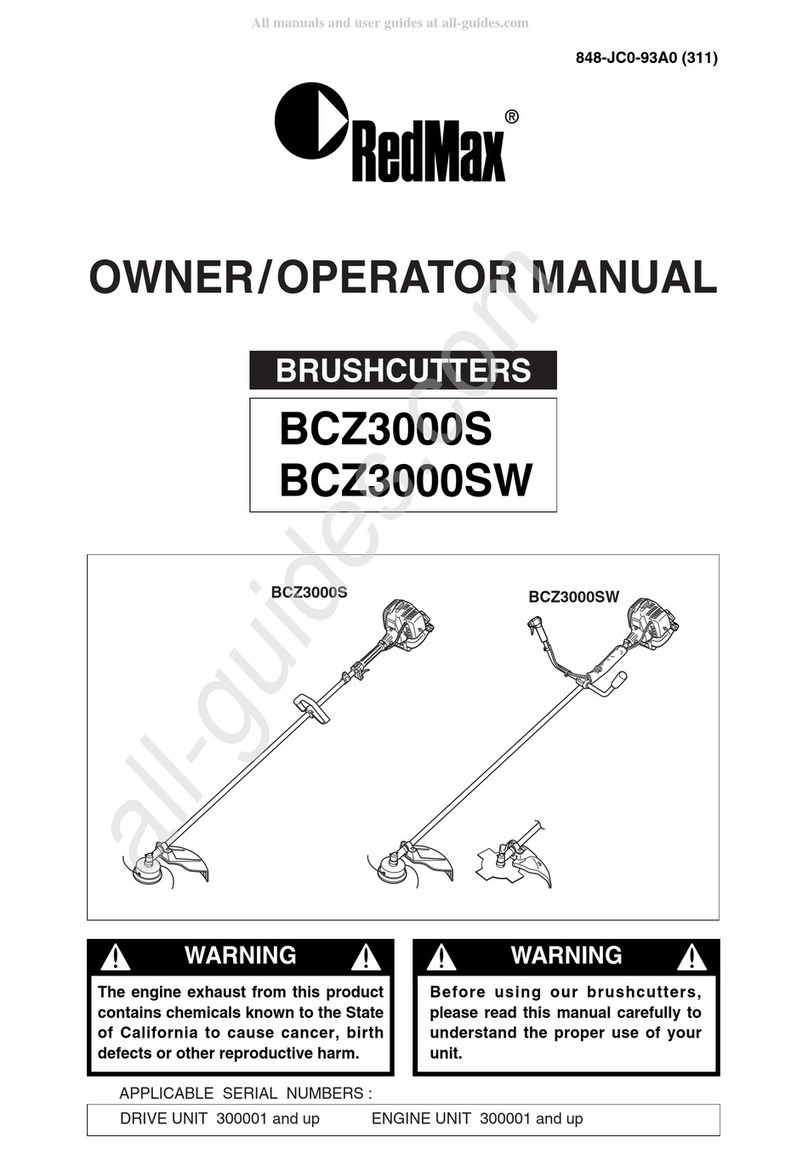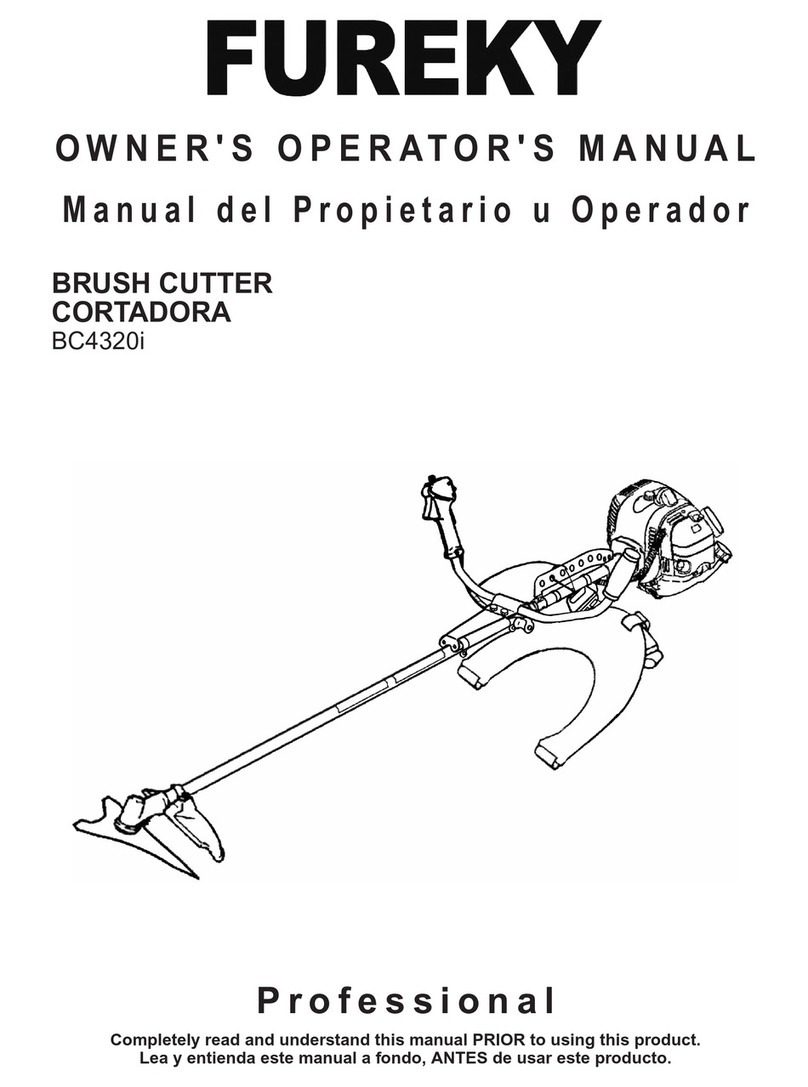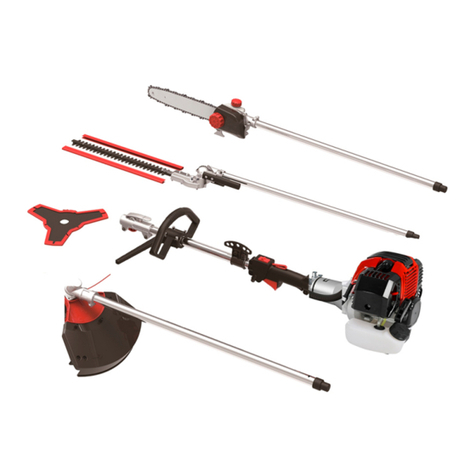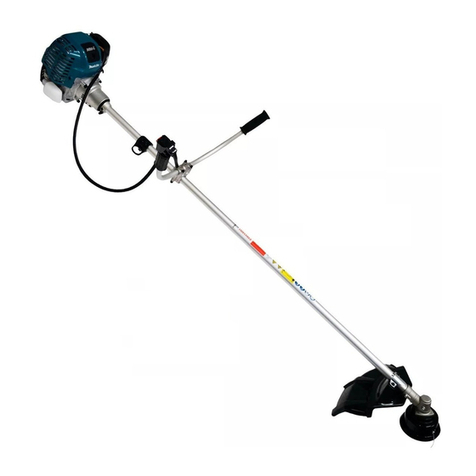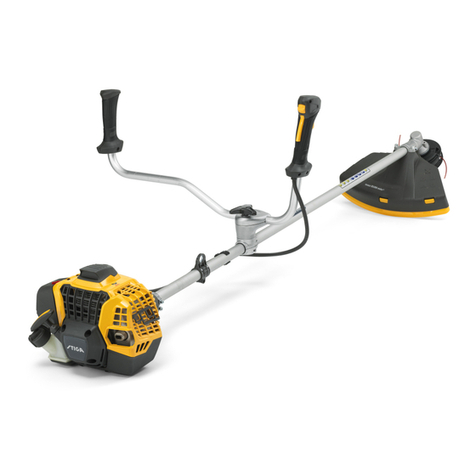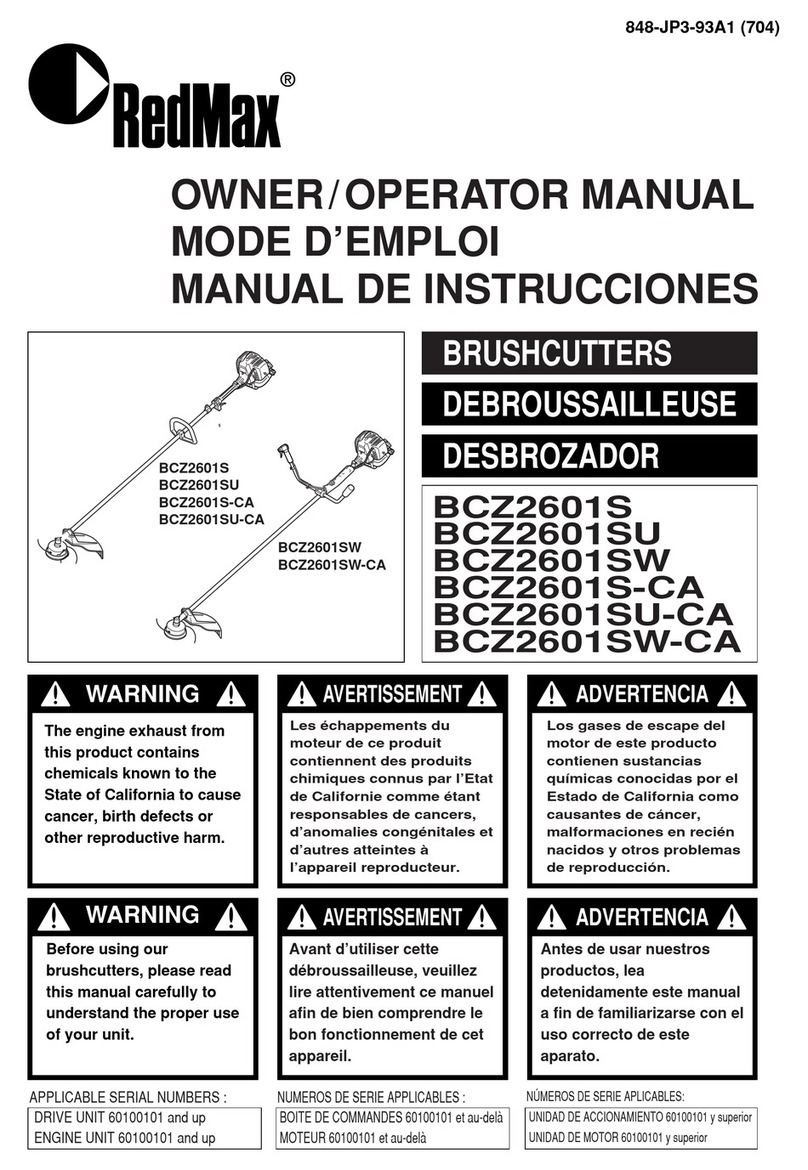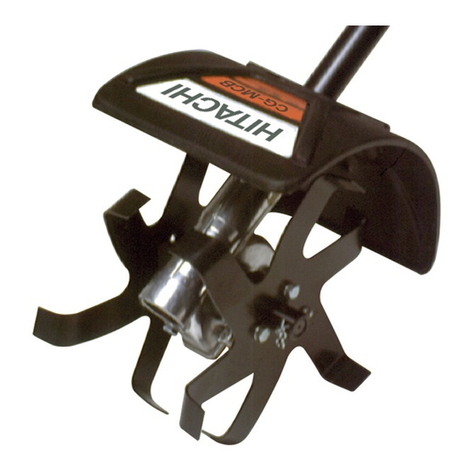Skid Steer ZABC42 Product manual

Skid Steer
Articulating Brush Cutter
OPERATOR'S AND PARTS MANUAL
Model:ZABC42
Rev.01

GENERAL SAFETY PRECAUTIONS
Operator Safety
It is the responsibility of the operator using this attachment to be acquainted with the
safe operation. In addition to reading this manual, it is important that the operator read
the skid steer's operation manual and follow its manufacturer's recommendations!
& Before raising, lowering or swinging the cutter, make sure area is clear of bystanders or
objects.
Machinery parts sometimes have sharp edges. Wear work gloves when moving parts.
Always use caution around cutter blades as they often are very sharp.
Never use drugs or alcoholic drinks when operating or servicing this piece of equipment.
Always wear the proper personal protection equipment when servicing or operating
this piece of equipment. Never service or operate this attachment with bare feet, sandals,
or another light footwear.
Always use eye protection during operation. Mount this attachment on a skid steer
equipped with thermoplastic polycarbonate door panel and side panels.
Speed Kills! Operate this implement at a safe working speed. When transporting the
implement, keep a safe speed to avoid losing control of the attachment or prime mover.
Keep proper clearance between the implement and objects (tree stumps, large rocks,
buildings, etc.). Contacting these objects with the implement or prime mover could cause
a loss of control or damage to the implement.
Before each operation of this implement, check all hardware (bolts, nuts, pins, cotter
pins, etc.) for their proper location and tightness.
Stop the engine on the skid steer and set the brake to avoid the implement rolling
forward or backwards while you are exiting the prime mover.
Store this implement in an area not frequented by children.
Allow no riders on this attachment. Keep all bystanders clear of attachment during
operation.
Always replace worn, torn or missing safety decals before operating.
Never operate the cutter when bystanders are within 300 feet of the work area.
Use caution when performing service work on or near the machine's battery. Do not
smoke near the battery as battery vapors could ignite.
Skid Steer Requirements
The Articulating Brush Cutter should only be used on skid steers with a lift capacity of
at least 1800 Ibs. and with a weight of at least 6500 with the bucket removed. A skid
steer equipped with tracks will provide superior stability in this application.
You will install the electrical joystick that accompanies this attachment or your skid
steer must be equipped with an auxiliary electrical option with an electrical connector
mounted on the machine's loader lift arm from the skid steer manufacturer. In order to
complete the connection, the mating connector on the loader arm needs to match the
connector from the attachment.
A 12 V power source coming directly from the battery or from some other circuit that
is energized all the time could result in Death or Serious Injury if the attachment control

switch is accidentally bumped when the operator is entering or exiting the skid steer with
the engine running.
Always refer to the polarity symbols printed on the top of the battery. Refer to the
markings on the battery to determine the location of the negative (-) cable. If the battery
cables are to be removed from the battery, always remove the negative cable first and
reinstall the negative cable last.
DO NOT smoke around a battery, or use anything that produces an open flame or spark
to avoid an explosion that could result in Death or Serious Injury.
The 12V power source for this attachment should be connected into the skid steer's
Operator Presence System that cuts the electrical power to the attachment shift valves if
the operator safety restraint bar is raised or the seat switch is disengaged when the
operator raises from the seat.
When using the provided joystick, route the electrical harness up to the pivot point of
the loader arm and tie it with plastic cable ties to the inside of the loader arm to prevent
snagging the harness with branches. After installing harness, check that the harness is
free from any tension when raising and lowering the loader arm through its complete
cycle.
To protect the operator from any flying debris, it is important that the skid steer is
equipped with a thermoplastic polycarbonate windshield or similar.

ARTICULATING BRUSH CUTTER DIMENSIONS

BASIC PARAMETER
OF ARTICULATING BRUSH CUTTER
Num
Item Parameter Remark
1 Overall Length 94"(vertical)
119"(tilt) model:ZABC42
2 Overall wide 50.8"
3 Overall height 53.7"
4 Cutting Width 42"
5 Material Cutting Up to 5 in dia
6 Cutting Blades 9/16x11.5x5 2 Blades
7 Max Swing Degree 90°
8 Max Head Tilt Degree 35°
9 Hydraulic Flow Required
14-20GPM
10 Max. pressure of oil 2000-2500 psi
11 Direct Current Voltage DC12V
12 Check Valve CIT-
03 G3/8
13 hydraulic cylinder 2.5"x1.5"x16〞 Stroke 16〞
14 hydraulic cylinder 2"x1.25"x8〞 Stroke 8〞
15 hydraulic control valve
Flow 25GPM
16 hydraulic control valve
pressure 3500 psi
17 Gearbox XH30.192Z.01L/03L
Speed Increasing Ratio 1:1.92
18 Chain Roller No.50 Chain Link 16
19 Weight 948 lbs
20 GPM MAX

INSTALLATION & SET-UP
Using Your Implement Connecting Cutter to Skid Steer
Verify that the hydraulic hoses and the wire harness are clear from the front of the
attaching plate on the attachment and that the mounting plate is free from dirt and
debris. When clear, move the skid steer to proximity of attachment plate. Tilt skid steer
coupler forward to align coupling point with the upper part on the attachment plate and
raise the coupler slightly.
Connecting Coupler to Attachment
When the top edge of the coupler is seated in the top part of the coupler plate, roll
the skid steer tilt function back until the attaching plate is flat against the skid steer
coupler. Lock down the coupler levers.
Wipe off any dirt or dust from the male or female hydraulic flat-face couplers with a
clean rag before attaching hoses, to keep contaminants from entering the hydraulic
system.
Connect the cutter hydraulic hoses to the auxiliary circuit connectors on the skid
steer. Connect the electrical harness to the appropriate connector on the skid steer.
Check the surrounding area for bystanders and clear them before starting the skid
steer or attachment.
Before operating the attachment, always visually inspect and verify that the coupler
lock pins are fully engaged through the latch slots on the attachment plate.
Never enter the area underneath the coupler or any part of the attachment when it
is in the raised position to avoid an accident that will result in Death or Serious Injury.
OPERATING INSTRUCTIONS
Cutter Boom Controls
The joystick control can be easily attached to the leg of the operator using the Velcro
straps provided.
Always turn the engine "off and remove the joystick controller from your leg before
exiting the skid steer cab to avoid unwanted machine or attachment movement that
could cause Death or Serious Injury.
In order to swing or tilt the cutter head, the auxiliary hydraulics to the cutter drive
must be turned on.
During operation you may notice that the cutter speed slows down a little while you
are activating the swing or cutter deck tilt. When you have completed swinging the boom
or tilting the cutter deck, the cutter will resume to its normal rotation speed.

Engaging Cutter Drive
First Time If this is your initial startup with this attachment on this machine, check
the skid steer's hydraulic oil level and add oil, if necessary, before and after doing steps 1-
6 below.
After starting skid steer, lift the attachment off the ground surface:
1. With the skid steer engine RPMs just above idle, engage the auxiliary hydraulic
flow to the cutter head. Use your machine's "Boom Swing" electric switch to rotate cutter
boom to the right. Stop when the cutter has rotated 90°.
2. Rotate the cutter head back to the straight-ahead position.
3. Rotate the "Cutter Tilt" using the electric control switch until the cutter hits the
stop.
4. Tilt cutter head in the opposite direction until it hits its stop.
5. Return cutter head to the level position and the cutter boom to the
straightforward position. Allow the cutter to run for 30 seconds to purge the air from the
system. Turn off the cutter drive, allowing it to come to a complete stop.
6. Lower the cutter attachment to the ground and shut off the skid steer's engine
and exit the operator's compartment.
7. Check the skid steers hydraulic oil level, and add oil if necessary.
8. Inspect the cutter hydraulic plumbing for any noticeable leaks. Correct these leaks
before continuing.
9. Restart the skid steer. With the attachment raised off the ground and the engine
throttle set just above idle, engage the cutter drive circuit to start cutter. Allow cutter to
come up to speed before increasing engine speed.
Starting the Cutter
Moving or engaging the cutter with bystanders in the area could result in Death or
Serious Injury. Before engaging cutter hydraulics, always make sure the area is clear of
bystanders. Engage the cutter drive hydraulics with the prime mover's engine at a low
rpm. Slowly raise the skid steer engine's rpm to the correct and desired cutter speed. Use
the skid steers throttle to set the speed; never use a foot throttle when using the cutter.
Stopping the Cutter
When stopping the cutter, raise the cutter slightly and lower the skid steer's engine
RPMs to an idle, and allow the cutter to slow down. After the cutter has slowed down you
may turn the auxiliary hydraulics to the "off" position.
Getting Familiar with the Attachment
Be cautious when operating on un-level ground surfaces. A machine rolls over could
result in Minor or Serious Injury. Always wear your seat belt when operating this
attachment.
Before starting the skid steer engine with this cutter attached, make sure you are
knowledgeable and comfortable with the operation of the brush cutter controls as

outlined in the previous and following sections of this manual.
Do not overspeed the cutter by allowing more than 20 GPM to the cutter head. This
attachment requires 14-20 gallons of flow to cut efficiently.
When operating the cutter, set the skid steer throttle at a speed that will produce
the required flow. Refer to your skid steer manual or call your local skid steer dealer for
additional help, if necessary. Your skid steer dealer can measure the flow available on
your machine and recommend a throttle setting that is compatible with this attachment.
To begin with, learn what the cutter head looks like in a level cutting position when
you are seated in the skid steer. Knowing what a level cutter head looks like will help you
avoid damage to the cutting blades by cutting too close to the ground surface.
Rotate the boom 90° to the right and learn what the level position looks like when
cutting off to the side of the skid steer. Rollout the skid steer's tilt cylinder and notice how
it affects the cutter head.
The correct ground speed for cutting with this attachment can be monitored by
sound and feel and depends on the material density. If the skid steer engine is bogging
down or if the cutter speed is turning too slow because of too much load, the ground
speed should be decreased.
Listen and feel for any strange vibration when working the cutter. A bad vibration
felt when cutting could indicate a damaged cutting blade, or material trying to be cut at
too fast a pace. Slow down the skid steers ground speed to see if vibration stops. If it does
not, stop the cutter, turn off the skid steer engine and investigate cause of vibration.
Refer to the Troubleshooting section in this manual for further instructions.
Always be aware of your surroundings. When the cutter is swung 90°, the operator
has a much larger path to lf the cutter creates a vibration when ramping up speed, turn
the cutter attachment to the off position and investigate cause. Refer today
Troubleshooting section in this manual.
Never operate the cutter when bystanders are within 300' of your work areas. Flying
debris could result in Death or Serious Injury. Keep aware of. While watching the cutter,
also pay attention to what obstacles or terrain are in front of the cutter boom and prime
mover. Maintain a safe speed while cutting.
Cutting brush and tree branches with the cutter in an elevated position could result
in Death or Serious Injury if the skid steer becomes unstable. Never raise the cutter more
a few feet off the ground when working on slopes or uneven terrain.
Adjusting Cutter Height & Level
Use the skid steer loader lift to adjust the elevation of the cutter. The fore & aft
leveling can be accomplished by using a combination of the tool cylinder mounted on the
boom and the skid steer's attachment tilt cylinders.
When the cutter is at the 0° position (straight in front of skid steer) the tool
cylinder on the boom can be moved to level the deck.
When the cutter is at the 90° position, it can be leveled by using the tool cylinder

connected to the attachment, as well as slight variations in the skid steer tilt
Swinging Cutter
keep all persons and objects away from this attachment while it is operating.
Your Articulating Brush Cutter has the capability of rotating 90° to the right of the
skid steers mounting point, or stopping anywhere between 0° and 90°.
Before swinging the boom to the right or back to center make sure there are no
objects in the way that could hinder the movement of the boom swing.
To rotate the cutter boom, push the joystick right or left for the boom swing function.
To tilt the cutter, move back to adjust the deck.
With the boom swung at 90°, make sure you are aware of any obstacles directly in
front of the skid steer or in front of boom, when moving the skid steer.
Use care when operating on uneven terrain or any type of sloped surface. Keep your
cutter low to the ground when working in these conditions to avoid a roll over that could
result in Minor or Serious Injury.
Determine a safe cutting pattern before swinging the boom and cutter. Stop the
forward progress of the skid steer loader until the boom is swung to the desired position
until you are fully familiar with the movement of the attachment.
Before Cutting
Inspect the area to be cut and make sure it is free of any utilities, rocks, fence posts, or
any other objects that you do not want to cut or that would damage the cutter.
Do not enter into an area to be cut before the cutter rotation come up to the operating
speed.
Cutting Tips
Never operate this attachment when bystanders are in proximity of the work area that
could result in Minor or Serious Injury from flying debris.
1. Always inspect work area before starting the cutter. Locate and mark any utilities,
steel posts, rocks or any other objects that could be damaged or would damage the
cutter during operation. Never assume the work area is safe and never skip the
inspection part before start of operation.
2. Operate at a safe slow-paced speed that will allow you to watch the area ahead of
the skid steer and also ahead of the boom and cutter when the cutter is swung away
from the straight-ahead position.
3. Make sure you are operating the skid steer's engine at an rpm that will produce
the volume of oil flow required for this attachment.
4. If the cutter speed slows down, reduced your travel speed and allow cutter to
reach the proper rotating speed. Mowing too fast in thick material could result in balling
of material underneath the cutter deck resulting in a loss of cutting efficiency.
5. Never use your cutter to push, pull, lift or move any type of object or vehicle. Do
not use this attachment to "push" down trees.

6. Always allow cutter to come up to operating speed before moving attachment
into the material you want to cut.
7. If material constantly is balling underneath cutter deck, try tilting the leading edge
of the cutter to be about 1" lower than the rear of the cutter. This should allow a more
efficient material flow under the cutter deck.
8. Use the v-notch in the top of the cutter deck to capture small trees (up to 3"
(76mm) for cutting.
Vertical Cutting
Your Articulating Brush Cutter has the capability to cut vertically to widen pathways,
roadways, or along the edge of a crop field to allow access for tractors and combines.
Vertical cutting can disperse debris over a large area. To avoid an accident that could
result in Death or Serious Injury, do not operate the cutter when bystanders are within
300' (91m).
To avoid Minor or Serious Injury, never swing the cutter boom past the side tipping
capacity of your skid steer when the cutter is in the raised and vertical position. Know the
capability of your machine and notice the terrain you are working on. Raise the skid steer
loader arm and tilt the cutter head to the vertical position. Swing the boom to the right
to access the area to be cut. Raise and lower the skid steer's lift to trim back over-
hanging branches.
HYDRAULIC ELECTRIC CONTROL SYSTEM
Read all safety decals and safety statements in all manuals before beginning any
hydraulic connection. Know and obey all OSHA regulations, local laws, and other
professional guidelines for your operation. Know and follow good work practices when
assembling, maintaining, repairing, mounting, removing, or operating this equipment.
Loaders
1. Disconnect the hydraulic hose quick couplers from one another and attach the quick
couplers to your prime mover as per the instructions in your prime mover's operator's
manual.
2. Carefully raise the loader and cycle the rollback/dump cylinders to check hose
clearances and to check for any interference. Operate the hydraulic cylinder(s) on this
product to make the same checks.
3. Cycle the hydraulic cylinder(s) on this product several times from fully retracted to
fully extended until all air has been completely removed from the cylinder(s).

MAINTENANCE
Blade Removal & Replacement
Cutter blades can be very sharp and could cause. Minor or Serious Injury if mishandled.
Always wear protective gloves and footwear.
Position the cutter attachment with cutter deck in the vertical position so you can
access the blade and holder bracket.

Blades & Holder
Sling the holder from the hoist and remove the bolts from the center of the blade
holder. Lower the holder to the floor or to a suitable work surface.
Use a cutting torch to remove the head of the blade mounting bolt, and drive the bolt
shaft out of the blade holder end. Install the new or sharpened blade into position and
secure the blade with a new bolt, bushing spacer & nut, and apply red thread lock to the
bolt threads.
Repeat this procedure on the other blade end before installing the holder back on the
attachment. Install new hardware to secure the holder to cutter drive. Torque the six
blade holder bolts to a minimum of 600 Ib-ft (813 Nm).
Always service (sharpen or replace) the blades as a set. Never run cutter with
unmatched blades.
Not maintaining your implement correctly could result in Minor or Serious Injury. Keep
your implement in top operating condition.
Before Every Use
Check that all fasteners (nuts, bolts, pins, keepers) are in their right place and are
tight.
Inspect and replace any worn, torn or missing safety decals.
Pump No.2 lithium or molybdenum disulfide grease into all required areas
until you see old grease is being flushed out.
Investigate the location of any oil leaks and repair.
After every use, clean off any dirt residue with a garden hose and repeat grease
application.
Every Week
Check the condition of the blades by raising the cutter attachment off the ground and
tilt the attachment back to the 90° position. Lower the attachment to the ground.
Inspect the cutter blades and remove and sharpen them if necessary. Sharp cutter
blades will cut more efficiently than dull blades.
After Every Season
Inspect the implement for any loose or worn parts that may need to be replaced prior
to the next cutting season.
Visually inspect the cutting blades. Sharpen or replace them, if necessary.
Clean, sand & repaint any area that looks worn or scratched to prevent further rusting.
Use an equipment paint found at your local hardware store or building center.
Lubricate all pivot joints. If located in an area near an ocean or other corrosive
conditions, apply a thin layer of grease to any exposed cylinder rod surfaces. Wipe grease
from cylinder rods with a clean rag when taking the attachment out of storage.
Store your implement in a shed or cover with a water-proof tarp to protect it from the
weather. Store in an area not frequented by children.

TROUBLESHOOTING
Problem Possible Cause Possible Solution
Cutter bogs
down
Deck is not properly leveled &
material is balling under deck Refer to leveling instructions found in this manual.
Dull blades Remove and sharpen blades.
Ground speed too fast Slow down ground speed.
Cutter speed too slow Raise engine RPMs or investigate other low oil flow
problem
Vibration felt
when running
cutter
Missing, loose, damaged or
unbalanced cutter blades
Replace blades with new or re-sharpened and equally
balanced blades.
Blade mount damaged Replace blade mount
Gearbox loose on deck Tighten & torque gearbox mounting bolts. Replace
bolts if they are damaged.
Cutting height too low for cutting in
sandy or rocky soils Raise cutter height.
Blades get dull
too quickly
Blades have contacted solid objects
(rocks, steel pipes, etc.)
Clear cutting area of solid objects before hitting them,
or raise the cutter height to clear exposed rock
surfaces.
Blades breaking Excessive shock loads Avoid hitting solid objects (rock, steel pipes, large tree
stumps, etc.).
Hydraulic oil
level goes down
during operation
Leak at valve, cutter motor or other
plumbing Investigate & repair
Leaks in skid steer hydraulic system Investigate & repair
Blades do not
spin when flow
is activated
Shear bolt between motor and
gearbox is sheared Replace with proper shear bolt specified for this unit.
Motor or gearbox failed
Disconnect the drive chain between motor & gearbox.
If blade holder can be turned by hand, motor failure is
suspect. Call the Factory for further instructions.
Check valve failure
Remove check valve from tees, cap the tees and
attempt to run cutter. If cutter spins, replace the check
valve.
Blades turn, but
cannot tilt or
swing cutter
No electrical power to controller or
solenoid valves
Check in-line circuit fuse. If blown, investigate cause &
replace.
Check connections at solenoid valves.
Check that circuit has a good ground.
Have local skid steer dealer check the Operator
Presence System

BOLT TORQUE SPECIFICATIONS
GENERAL TORQUE SPECIFICATION TABLES
Use the following charts when determining bolt torque specifications when special
torques are not given. Always use grade 8.8 or better when replacing bolts.
METRIC BOLT TORQUE SPECIFICATIONS
The following torque values are for use with metric Bolt head identification marks as per
grade. hardware that is unplated and either dry or lubricated with engine oil. Reduce
torque 15% when using hardware that has extreme pressure lubricants, plating or hard
washer applications.
Table of contents
